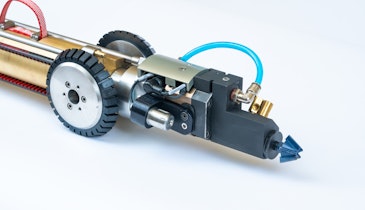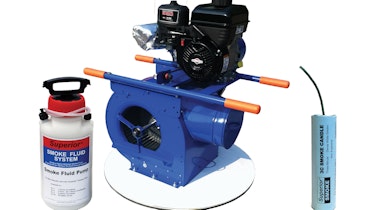Computerized maintenance management systems (CMMS) have become almost essential for water, wastewater and stormwater departments with numerous fixed and mobile assets. These systems make it easy to schedule and complete maintenance tasks, track inventory, assign staff, monitor costs, and generate management reports.
The Web Work CMMS from Tero Consulting Ltd. in Vancouver, B.C., is an advanced CMMS offering designed to help government and private entities manage operations and maintenance functions across an enterprise network Web. The company says the program was the first commercially available CMMS developed using web architecture, providing functionality through a standard web browser.
The system is designed to be flexible and scalable and to adapt easily to suit organizations of many sizes and people with a wide range of computing skills. In particular, it is structured to enable staff members without computer programming knowledge to customize functions and reports.
Ronald Kossik, vice president, technology, with Peak Industrial Solutions LLC, a Web Work distri-butor, gave an Internet-based demonstration of the software on Dec. 31.
Walk-around
Web Work is available both for purchase and in an application service provider (ASP) model, in which the user does not host the software on local servers. Instead, the software is hosted remotely by a vendor, and users access it via the Internet.
In the ASP mode, the user is spared the expense of server hardware, software installation and updating, and system maintenance and support. Staff members can access data and use all software functions securely from any computer that has Internet access and a standard web browser.
One key advantage of the web-based model is that field personnel can enter service requests or work orders themselves instead of having to fill out paper forms or phone requests in to the office. This eliminates the errors that can occur when office staff members have to transfer data from forms or telephone notes into the computerized system.
The core modules of Web Work are all accessed from a main screen. The main modules are listed on the left side: Maintenance, Assets, Inventory, Purchasing, and Administration. A click on any of these brings up a menu of options, each leading to standard but customizable forms.
Operation
Starting from the main screen, Kossik demonstrated the basic functions common to all CMMS (work orders, service requests, inventory control, reporting and others) and highlighted various attributes unique to the Web Work offering.
From the Assets menu, Kossik pulled up an asset list and selected an emergency generator. A form appeared showing a variety of data on that asset, including fields displaying downtime and cost to maintain to date. “This lets the user know how much as been spent on maintenance and repairs for the asset over its life,” Kossik said.
He then demonstrated how assets can be categorized by main type and up to five subtypes. For example, under the main type Pumps, users could designate Subtype 1 as lift station pump or mobile bypass pump, Subtype 2 as hydraulic pump or vacuum pump, and so on. This greatly simplifies the process of searching for and generating reports on specific types of assets.
This same basic functionality supports the creation of hierarchies (or “parent-child” relationships) among related assets. For example, a hierarchy might consist of a wastewater lift station and its pumps and other components. Such hierarchies enable users to generate reports show how much they are spending on lift stations as a whole and how much are on each type of component within those stations.
The program also alerts users to equipment warranty status. ““If you try to issue a work order for asset, the software will tell you right away that the equipment is under warranty,” Kossik said. Often, he said, technicians are in a fire-fighting mode and fail to check on warranty status. This feature helps identify repairs that should properly be carried out under warranty rather than at the community’s expense.
Users also can define individual lists of specifications for each type of asset (motor, pump, vehicle, generator, manhole, and others); specific lists of spare parts needed for maintenance with inventory levels and ordering information; and service intervals based on number of days or odometer or hour-meter readings.
Tabs across the top of the screen let users expand and refine the definitions of planned maintenance (PM) activities. Within the Estimates tab, for example, users can define the tasks, labor, materials, and tools expected to be required.
Searches are easily performed using a query function. At the bottom of the Maintenance screen, Kossik clicked on the word Query, bringing up a form on which he showed how to search for PM activities on a specific asset class. Going to the Department field, he clicked a magnifying class search icon and brought up a list. From that list he selected HVAC, and a list of HVAC-related PM items appeared.
He also showed how the same result is obtained by simply typing the name of the desired item into the appropriate field in the form. More advanced queries to sort for two, three or more attributes can be created simply by marking attributes in a checklist. The query functions work the same way in all modules.
The software also enables creation of inspection or maintenance routes as single work orders with multiple components. This eliminates the need to create and print individual work orders for simple, repetitive tasks, such as exercising water valves or inspecting manhole structures. To illustrate creation of a route, Kossik:
• Selected a smoke detector from a list of items.
• For that item created a specification called Quarterly Inspection.
• Entered P (for pass) as a default value.
• Entered P/F (for pass/fail) as the measurement unit.
He then followed the same procedure for additional smoke detectors to be inspected as part of the route. After creating such a series, Kossik selected New Route, named it Smoke Detectors Floor 2, and selected the two Quarterly Inspection items to add them to the route.
The same process can be used to specify multiple measurements for each piece of equipment where appropriate (for example, pressure, flow, temperature).
Kossik then displayed a form for a route containing inspection items. This form represents a single work order with a checklist on which the technician can enter the pass/fail ratings. The form can be printed out and filled in manually, or can be completed on a PDA and uploaded to the CMMS upon completion.
“It’s a PDA-based program that the values can be downloaded to,” Kossik says. “The technicians can go through and record the values as they walk around. The program will automatically tell what the next item on the route is. It’s a powerful framework for allowing a large number of pieces of equipment to be serviced without generating an unreasonable number of paper or electronic work orders,” Kossik said.
The program’s inventory function integrates with the other maintenance functions. Once PM tasks are defined with parts requirements, the system can be used for predictive ordering. Kossik demonstrated an Inventory Reorder report showing items’ current stock level, quantity on order, and reorder level.
The Report Writer function is designed for more experienced users. The system allows administrators to set security limits to define who is allowed to generate reports. Those users generally receive training in the reporting functions. The system includes a list of standard reports and also allows users to create custom reports.
Observer comments
The Web Work software appears to provide a high degree of flexibility and enables experienced as well as entry-level users to work in the system efficiently. As one example, the software lets users conduct queries either by selecting items from lists or by typing in the name of the desired item into a data field. The former method is easier for entry-level users, but would tend to slow down experienced users.
The route creation function would be faster and easier if users could create a route simply by running a search for similar items instead of having to enter each item manually. However, the user has to go through the selection of items only once, after which the route itself becomes a complete work order.
Manufacturer comments
Kossik noted that the system combines high-level functionality that advanced users need with simple and intuitive attributes that help entry-level users. Operation of basic functions, such as query, is consistent across all modules.
“A low threshold of approachability of the software is important from a training perspective,” Kossik said. “With the web-enabled ASP model, the cost of installing, configuring and maintaining software is greatly reduced, so the cost of running a CMMS shifts to staff training and support. The low threshold of expertise required for a new staff member to begin using this system is an advantage.”
He observed that the need to build inspection or maintenance routes item by item is a trade-off on behalf of making the system easy for inexperienced personnel to use. “One service that we can offer is that we can build those routes automatically to reduce manual setup,” he said. “That cuts the job down to size for larger customers.”
Organizations large enough so that route creation becomes a tedious process generally have the wherewithal to support consulting and integration services that can include automatic route creation, he said.
“Two key attributes of this program are its adaptability to the customer’s operation without programming or other special expertise, and the ability to set up routes so that large-volume, short-duration maintenance activities can be automated in ways that save manpower and enhance efficiency in completing PM schedules,” Kossik concluded.





